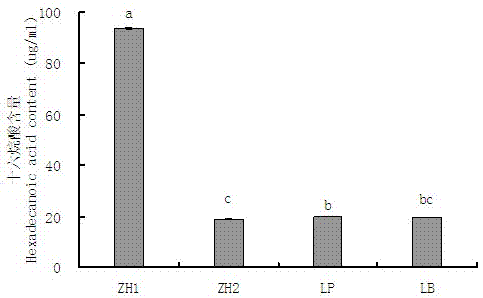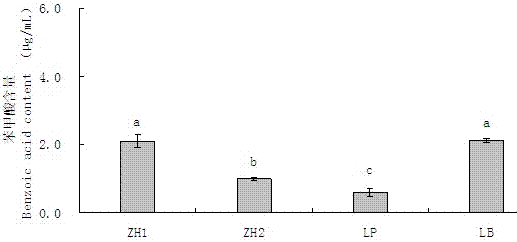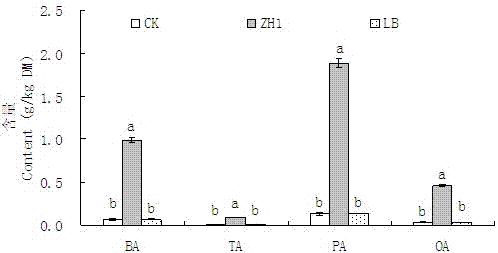Lactobacillus strain lactobacillus parafarraginis ZH1 and application thereof
A technology of lactic acid bacteria and microbial strains, applied in the directions of application, bacteria, microorganisms, etc., can solve the problem of insignificant effect, and achieve the effect of unique effect, easy utilization, and overcoming easy aerobic deterioration.
- Summary
- Abstract
- Description
- Claims
- Application Information
AI Technical Summary
Problems solved by technology
Method used
Image
Examples
Embodiment 1
[0025] Embodiment 1 screens the good lactic acid bacteria of high yield benzoic acid and hexadecanoic acid
[0026] The lactic acid bacteria strain ZH1 isolated from Sudan grass silage was subjected to Gram staining and cell shape observation, and was tested according to growth temperature (10, 15, 20, 25, 30, 35, 40, 45, 50°C) and growth pH ( 3.5, 3.75, 4.0, 4.5, 5.0, 5.5, 6.0, 6.5, 7.0, 7.5, 8.0, 8.5, 9.0), physiological and biochemical experiments such as benzoic acid and hexadecanoic acid produced in MRS. The results showed that the ZH1 strain was a Gram-positive, heterofermentative bacillus that could grow at 15-45°C and pH4.0-8.5, and had strong acid resistance (Table 1); it could ferment most sugars ( Table 2); in MRS can produce more benzoic acid and hexadecanoic acid ( figure 1 and figure 2 ).
[0027] project characteristic Gram stain detection Positive Catalase activity Negative shape Rod fermented glucose form Shaped ...
Embodiment 2
[0040] The identification of embodiment 2 lactic acid bacteria
[0041] The bacterial strain obtained in Example 1 was cultured overnight at 37°C in 5 mL of MRS medium, and the bacterial solution was transferred into a 1.5 mL centrifuge tube, centrifuged at 10000 rpm / min for 3 min to 5 min to collect the bacteria, and TE 0.1 (10 mmol / L Tris–HCl, 0.1 mmol / L EDTA, pH 8.0) was washed twice, and DNA was extracted with TIANamp Bacteria DNA Kit (TIANGEN BIOTECH CO., LTD, Beijing, China) and detected at OD600 nm its absorbance value. Then, carry out PCR amplification, 16S rDNA amplification primers are 25f (SEQ ID NO:1) and 1492r (SEQ ID NO:2), RCR reaction is 95°C (5 min) - 94°C (30 s) - 55 °C (1 min)-72 °C (1.5 min)-72 °C (10 min), 94 °C (30 s)-55 °C (1 min)-72 °C (1.5 min) reaction cycle 30 times. The amplified product was sent to Huada Gene Co., Ltd. (China) for sequencing, and the results were compared on the NCBI gene bank to find out the standard strain Lactobacillus zeae ...
Embodiment 3
[0042] Example 3 Effects of adding to silage
[0043] Silage addition experiments were carried out with lightly aired and non-aired yellow oats and corn stalks as materials. Cut the material to 1 cm~2 cm, mix evenly, and add about 1.0×10 strain ZH1 per kg of material 8 indivual. Add the material after the bacterial strain ZH1 identified in Example 2 into a polyethylene silage bag of 30 cm × 20 cm, and pack 6 bags for each treatment. 3 bags are stored at 45° C., and 3 bags are stored at 15° C., about 200 g per bag. Air was pumped and sealed with a vacuum sealing machine, and the yellow oat silage was stored at 15°C for 45 days.
[0044] Under the low temperature storage condition of 15℃, both the non-dried yellow oat silage and the sun-dried yellow oat silage produced more lactic acid and ammoniacal nitrogen, less acetic acid, more yeast and less than 40% aerobic stability. Hours; the yellow oat silage added with Lactobacillus Brucella also produced more lactic acid, le...
PUM
 Login to View More
Login to View More Abstract
Description
Claims
Application Information
 Login to View More
Login to View More - R&D
- Intellectual Property
- Life Sciences
- Materials
- Tech Scout
- Unparalleled Data Quality
- Higher Quality Content
- 60% Fewer Hallucinations
Browse by: Latest US Patents, China's latest patents, Technical Efficacy Thesaurus, Application Domain, Technology Topic, Popular Technical Reports.
© 2025 PatSnap. All rights reserved.Legal|Privacy policy|Modern Slavery Act Transparency Statement|Sitemap|About US| Contact US: help@patsnap.com



